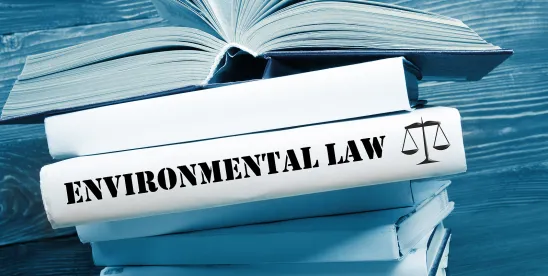On 30 June 2025, both the US Department of Energy (DOE) and the Federal Energy Regulatory Commission (FERC or the Commission) announced revisions to their respective National Environmental Policy Act (NEPA) procedures to speed up the permitting process for energy infrastructure. To achieve this objective, both agencies updated their regulations to remove references to recently rescinded White House Council on Environmental Quality (CEQ) NEPA implementing regulations. Both agencies aligned their regulations with directives from President Trump’s Executive Order 14154. Finally, both agencies issued corresponding, nonbinding guidance documents. These changes are expected to have a material impact on the process and timing of energy infrastructure, especially natural gas pipelines and LNG facilities.
One notable difference between the two approaches is that FERC’s modifications are less aggressive than DOE’s changes. FERC presents its revisions as more technical in nature and merely focused on removing references that are no longer applicable, while the staff guidance manual suggests subtle shifts in FERC practice and more directly states policies that appear to have been guiding FERC’s recent approach to NEPA review. By contrast, DOE makes significant changes in its interim final rule that dramatically streamline and reshape its NEPA implementation regulations.
Together, these revisions represent a significant shift in NEPA policy and process for FERC- and DOE-reviewed projects. While DOE takes a more aggressive approach than FERC in streamlining its NEPA process, both agencies fall in line with other federal agencies seeking to update their own NEPA processes in response to directives from President Trump, Congress, and the Supreme Court (Court).
The release of updated NEPA implementing regulations by two of the primary energy agencies also signals a government-wide commitment to speed up permitting for US energy projects. That said, project developers seeking NEPA review under FERC or DOE should be mindful of distinctions between evolving NEPA review processes and procedures among FERC, DOE, and other agencies.
Background
In Executive Order 14154, Unleashing American Energy,1 President Trump called for achieving American energy dominance through efficient permitting, including by directing agencies to revise their NEPA implementing procedures. Executive Order 14154 also rescinded President Jimmy Carter’s Executive Order 11991, Relating to Protection and Enhancement of Environmental Quality,2 which had directed CEQ to promulgate regulations and required federal agencies to comply with CEQ regulations for almost 50 years. In response, CEQ rescinded its NEPA implementing regulations, effective 11 April 2025.3
As we previously reported, the Court’s 29 May 2025 decision in Seven County Infrastructure Coalition v. Eagle County signaled that a “course correction” was needed for cases under NEPA, holding that a law originally meant to be a procedural check to inform agency decision-making had instead grown to paralyze it. The Court concluded that agencies are the factual experts when making determinations about environmental impacts and, therefore, should be afforded substantial deference by reviewing courts. Seeking to further streamline the process, the Court signaled that future NEPA reviews should be narrower in scope, more concise, and take less time.
As a precursor to these most recent developments, Congress made significant amendments to NEPA in the Fiscal Responsibility Act of 2023 (FRA) (Public Law 118-5). But more than two years later, DOE and FERC had yet to modify their respective implementing procedures in response to the FRA—until now.
DOE and FERC’s updates to their respective NEPA implementing regulations to streamline their regulatory processes come in the wake of these developments. As DOE’s interim final rule states, “[t]his revision has thus been called for, authorized, and directed by all three branches of government at the highest possible levels.”4
FERC’s Updated NEPA Procedures
In Monday’s decision, FERC revised its NEPA implementing regulations at 18 CFR part 380 and its Rules of Practice and Procedure at 18 CFR part 385.5 FERC explained that the update, as directed by Executive Order 14154, removes all references to the now inoperative CEQ regulations, and where applicable, replaces those references with citations directly to the NEPA statute itself. Unlike DOE’s updates (discussed in more detail below), FERC’s revisions are framed as an update that effectively continues its standard approach to NEPA reviews. FERC’s updates to its NEPA implementing regulations are part of a final rule that becomes effective 45 days after publication in the Federal Register.6
Concurrently, FERC also issued a staff guidance manual7 that describes the process by which Commission staff will:
- Determine what actions are subject to NEPA’s procedural requirements and the requisite level of NEPA review;
- Ensure that relevant environmental information is identified and considered early in the process in order to support informed decision-making;
- Conduct coordinated, consistent, predictable, and timely environmental reviews, and reduce unnecessary burdens and delays; and
- Implement NEPA’s mandates regarding lead and cooperating agency roles, page and time limits, and applicant preparation of environmental documents.
FERC explained that the new manual is nonbinding and that nothing in it “should be interpreted as supplanting or curtailing any obligation the Commission has under federal laws.”8
There are a few aspects of FERC’s nonbinding guidance manual that are worth noting. For instance, “Commission staff will not require new scientific and technical research or the development of new methodologies to inform its analyses unless that is essential to a reasoned choice among alternatives and the overall costs and time frame of such undertaking are not unreasonable. Rather, staff will make use of what it deems to be reliable existing data and resources.”9 Further, the manual explicitly incorporates the page limit and timeline requirements that were recently added to NEPA in the FRA.
However, the manual generally appears to provide a continuation of FERC’s standard and ongoing practices, albeit with a more subtle emphasis on streamlining review and avoiding unnecessary process. In announcing the new regulations, Chairman Mark Christie stated that FERC “will continue to ensure that our environmental reviews are legally durable so projects stand up in court and get built.”10
DOE’s Updated NEPA Procedures
DOE issued notice of an interim final rule to revise 10 CFR part 1021, removing whole swaths of DOE’s NEPA regulations to simplify the regulations and leave only the provisions related to DOE’s existing categorical exclusions and related requirements, as well as a provision for emergency circumstances.11 As DOE explained, “[t]hese procedures, therefore, attempt to align NEPA with its Congressionally mandated dimensions, reflecting the guidance given also by the President and the Supreme Court, and making review under it faster, more flexible, and more efficient.”12 The interim final rule is effective immediately and comments are due within 30 days after the date of publication in the Federal Register.13
In the interim final rule, DOE revised appendix A in 10 CFR part 1021 to align with DOE’s new NEPA implementing procedures that it will publish separately from its revisions to the Code of Federal Regulations. Appendix A in 10 CFR part 1021 formerly contained categorical exclusions but now contains administrative and routine actions that do not require NEPA review. DOE also revised 10 CFR part 205, subpart W, to remove NEPA procedures from its regulations governing presidential permits.14
DOE explained in the interim final rule that “[o]ther than these few provisions, DOE’s procedures will henceforth be contained in the US Department of Energy National Environmental Policy Act (NEPA) Implementing Procedures,”15 and that a copy of the nonbinding guidance is reprinted for “explanatory purposes only” (and will not be codified in the CFR).16 By placing most of the NEPA procedures in sub-regulatory guidance, they are now nonbinding on the agency and DOE retains discretion to adopt different approaches on a “case-by-case basis.”17 DOE implicitly acknowledged that these actions preclude the requirement for notice and comment that would normally kick in when an agency proposes new or modified regulations.
Notably, DOE’s new NEPA guidance appears to be a paradigm shift for NEPA reviews, where the agency’s first step now is to look for an applicable categorical exclusion from NEPA altogether, and if one does not already exist, the agency is to consider whether to establish a new exclusion. DOE’s guidance also signals a strong desire to streamline reviews—continuing to provide for some public comment during the environmental review while emphasizing that no statutory requirement exists to post draft environmental impact statements for public comment.
DOE affirmed that the agency does not need to conduct NEPA analyses in issuing presidential permits because, in those instances, DOE does not act pursuant to its congressionally established authority as a federal agency, but rather on behalf of the president pursuant to a delegation of the president’s authority under the United States Constitution.18
DOE retained the existing categorical exclusions in appendix B and related requirements to “avoid any uncertainty” about the continuation of its already-established categorical exclusions or the procedural mechanism through which DOE established them.19 Importantly for the liquefied natural gas industry, DOE retained its categorical exclusion for the export of natural gas and associated transportation by a marine vessel, which is now found at appendix B, item B5.7. DOE also retained a provision in the regulations for action in emergency situations to ensure that DOE can respond in a timely way to any such event and to avoid any confusion regarding the continued validity of this already-established provision for action in emergency situations.
Notwithstanding the fact that DOE left in place the existing categorical exclusions in the regulations, DOE will nonetheless use noncodified procedures to respond to new developments, asserting that the flexibility “outweighs the appeal of codifying its regulations going forward.”20 Instead of codifying these procedures, DOE will post them online, enabling DOE to “rapidly update” them in response to future court decisions and presidential directives.21
Takeaways
FERC’s and DOE’s revisions are part of a larger administration-wide effort to rework the federal government’s NEPA review processes to speed up US energy infrastructure development. While FERC’s updates to its regulations are primarily a continuation of business as usual, albeit with a commitment to speeding up the process as reflected in the nonbinding staff guidance document, DOE’s revisions provide a clearer and more immediate shift in DOE’s overall approach to NEPA reviews in response to federal government directives. Given the number and pace of substantial developments in this space, project developers should remain mindful of the evolving NEPA procedures and policies of each relevant agency throughout the entire project-planning process.
1 90 FR 8353 (20 January 2025).
2 42 FR 26967 (25 May 1977).
3 90 FR 10610 (25 February 2025) (rescission effective on 11 April 2025).
4 US Department of Energy, Revision of National Environmental Policy Act Implementing Procedures, Notice of Interim Final Rule, at 4 (June 30, 2025), https://www.energy.gov/nepa/articles/notice-interim-final-rule-2025 (DOE Notice).
5 Removal of References to the Council on Environmental Quality’s Rescinded Regulations, Order No. 908, 191 FERC ¶ 61,237 (30 June 2025).
6 The final rule was published in the Federal Register on 3 July 2025. Removal of References to the Council on Environmental Quality’s Rescinded Regulations, 90 FR 29423 (3 July 2025).
7 FERC, Office of Energy Projects, Staff Manual on Implementation of the National Environmental Policy Act (June 2025), https://www.ferc.gov/media/staff-guidance-manual-implementation-national-environmental-policy-act-june-2025s.
8 Id. at 1.
9 Id. at 14.
10 FERC, News Releases: FERC Revises NEPA Procedures to Make Permitting More Efficient (30 June 2025), https://ferc.gov/news-events/news/ferc-revises-nepa-procedures-make-permitting-more-efficient#:~:text=Docket%20No.&text=14154%2C%20the%20Council%20on%20Environmental,the%20now%20inoperative%20CEQ%20regulations.
11 DOE Notice at 1.
12 Id. at 15.
13 The final rule was published in the Federal Register on 3 July 2025. Revision of National Environmental Policy Act Implementing Procedures, 90 FR 29676 (3 July 2025).
14 NEPA defines “major Federal action” as “an action that the agency carrying out such action determines is subject to substantial federal control and responsibility.” 42 U.S.C. 4336e(10)(A). Unlike executive agency final action, the decision to issue a presidential permit resides solely with the president, and NEPA therefore does not apply to the act of granting, modifying, or denying a presidential permit. See Executive Order 13867, Issuance of Permits with Respect to Facilities and Land Transportation Crossings at the International Boundaries of the United States, 84 FR 15491, section 2(i) (15 April 2019).
15 DOE Notice at 5.
16 Id.
17 Id. at 83.
18 Id. at 6. DOE explains that it is removing the NEPA procedures within its presidential permits regulations at 10 CFR part 205, subpart W, and that it has previously stated that it issues presidential permits pursuant to authority delegated by the president under Executive Order 10485, as amended by Executive Order 12038. The authority delegated to DOE by the executive order does not derive from any act of Congress but arises “by virtue of the authority vested in [the President] as President of the United States and Commander in Chief of the armed forces of the United States[.]” 18 FR 5397 (preamble). Further, NEPA is not required for the issuance of a presidential action, such as the issuance of a presidential permit. See Franklin v. Massachusetts, 505 US 788, 800 (1992) (holding the president is not subject to judicial review under the APA, given the separation of powers and the unique constitutional position of the President); see also Dalton v. Specter, 511 US 462, 469-471 (1994); Portland Audubon Soc’y v. Endangered Species Committee, 984 F.2d 1534, 1547 (9th Cir. 1993); and, Greene County. Planning Bd. v. Fed. Power Comm’n, 528 F.2d 38 (2d Cir. 1975) (holding that issuance of a presidential permit by DOE’s predecessor agency was not subject to judicial review under the Federal Power Act because the issuance of such a permit is “a function rooted in the President’s power with respect to foreign relations if not as Commander in Chief of the Armed Forces”).
19 Id. at 7.
20 Id. at 13.
21 Id.
Tad J. Macfarlan contributed to this article









 />i
/>i

